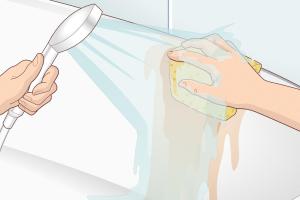Effortless Techniques to Remove Paint from Your Acrylic Tub or Bath

-
Quick Links:
- Introduction
- Understanding Acrylic Baths
- Why Paint Removal is Necessary
- Tools and Materials Needed
- Step-by-Step Guide to Remove Paint
- Case Studies
- Common Mistakes to Avoid
- Expert Insights
- FAQs
- Conclusion
Introduction
Acrylic bathtubs are a popular choice for many homeowners due to their durability, ease of maintenance, and aesthetic appeal. However, accidental paint splatters during home improvement projects can detract from their beauty. This article provides comprehensive methods to effectively remove paint from your acrylic tub without causing damage.
Understanding Acrylic Baths
Acrylic baths are made from a thermoplastic material that is lightweight, flexible, and resistant to chipping and cracking. This type of tub is easy to clean but can be sensitive to harsh chemicals and abrasive tools, making it essential to choose the right paint removal strategy.
Why Paint Removal is Necessary
Paint stains not only affect the appearance of your bath but can also lead to long-term damage if not addressed appropriately. Left untreated, paint can trap moisture, leading to mold and mildew growth, which poses health risks.
Tools and Materials Needed
- Plastic scraper or putty knife
- Warm soapy water
- Soft cloth or sponge
- Acetone or nail polish remover (as a last resort)
- Rubbing alcohol
- Paint thinner (ensure it's safe for acrylic)
- Protective gloves
- Masking tape
- Vinegar and baking soda (optional for gentle cleaning)
Step-by-Step Guide to Remove Paint
1. Assess the Type of Paint
Before you start, determine whether the paint is water-based or oil-based. This will dictate the method you use for removal.
2. Gather Your Supplies
Collect all necessary tools and materials mentioned above.
3. Test a Small Area
Before applying any substance to the entire painted area, test it on a small, inconspicuous spot to ensure it doesn’t harm the acrylic surface.
4. Soak the Area
Soak a soft cloth in warm soapy water and place it over the paint-stained area. Let it sit for 10-15 minutes to soften the paint.
5. Scrape Gently
Using a plastic scraper or putty knife, gently scrape the paint off the surface. Always work in the direction of the grain to avoid scratches.
6. Apply Rubbing Alcohol
If the paint persists, apply a small amount of rubbing alcohol to a cloth and dab it on the paint. Wait a few minutes and then scrape again.
7. Use Acetone as a Last Resort
For stubborn paint, apply a small amount of acetone (or nail polish remover) to a cloth. Test on a small area first and use sparingly, as it can damage the acrylic.
8. Clean the Area
Once the paint is removed, wash the area with warm soapy water to remove any residues from solvents.
Case Studies
Numerous homeowners have faced the challenge of removing paint from their acrylic tubs. Below are select case studies showcasing different methods and results:
Case Study 1: DIY Removal with Vinegar and Baking Soda
A homeowner used a combination of vinegar and baking soda to safely remove water-based paint. The process involved applying vinegar to the paint, followed by a sprinkle of baking soda. The chemical reaction helped lift the paint without damaging the tub.
Case Study 2: Professional Help
In another instance, a homeowner opted for professional cleaning services when the paint was oil-based. The professionals used specialized acrylic-safe products and steam cleaning methods, yielding excellent results.
Common Mistakes to Avoid
- Using abrasive tools: Always opt for plastic scrapers over metal ones.
- Neglecting to test: Always test on an inconspicuous area first.
- Excessive scrubbing: Be gentle to avoid scratches on the acrylic surface.
- Using harsh chemicals: Avoid bleach and strong solvents that can damage acrylic.
Expert Insights
According to experts in home maintenance, understanding the type of paint and the condition of your acrylic tub is crucial for successful removal. Many recommend opting for vinegar and baking soda as a first step due to their non-toxic nature and effectiveness.
FAQs
1. Can I use a heat gun to remove paint from my acrylic tub?
No, using a heat gun can warp or damage the acrylic material.
2. Is it safe to use paint thinner on acrylic?
Only use paint thinner if it specifies it's safe for acrylic. Always test a small area first.
3. How long should I let vinegar sit on the paint?
Let vinegar sit on the paint for about 10-15 minutes before scraping.
4. What should I do if the paint won’t come off?
If the paint persists, consider seeking professional help or using specialized acrylic paint removers.
5. Will rubbing alcohol damage my acrylic tub?
Rubbing alcohol is generally safe for acrylic, but always test on a hidden area first.
6. Can I prevent paint from getting on my tub in the future?
Using painter’s tape and drop cloths can help protect your acrylic tub during painting projects.
7. Is it better to remove paint right away?
Yes, the sooner you address paint stains, the easier they are to remove.
8. Can I use bleach to clean the tub after paint removal?
Avoid bleach, as it can discolor and damage acrylic surfaces.
9. How do I clean my tub after removing paint?
Wash the tub with warm soapy water and a soft sponge to remove any residue.
10. Are there commercial products for removing paint from acrylic?
Yes, there are specialized acrylic-safe paint removers available; just ensure they are specifically labeled for use on acrylic.
Conclusion
Removing paint from your acrylic tub may seem daunting, but with the right tools and techniques, it can be done effectively and safely. By following the steps outlined in this article and avoiding common pitfalls, you can restore your bath to its original beauty.